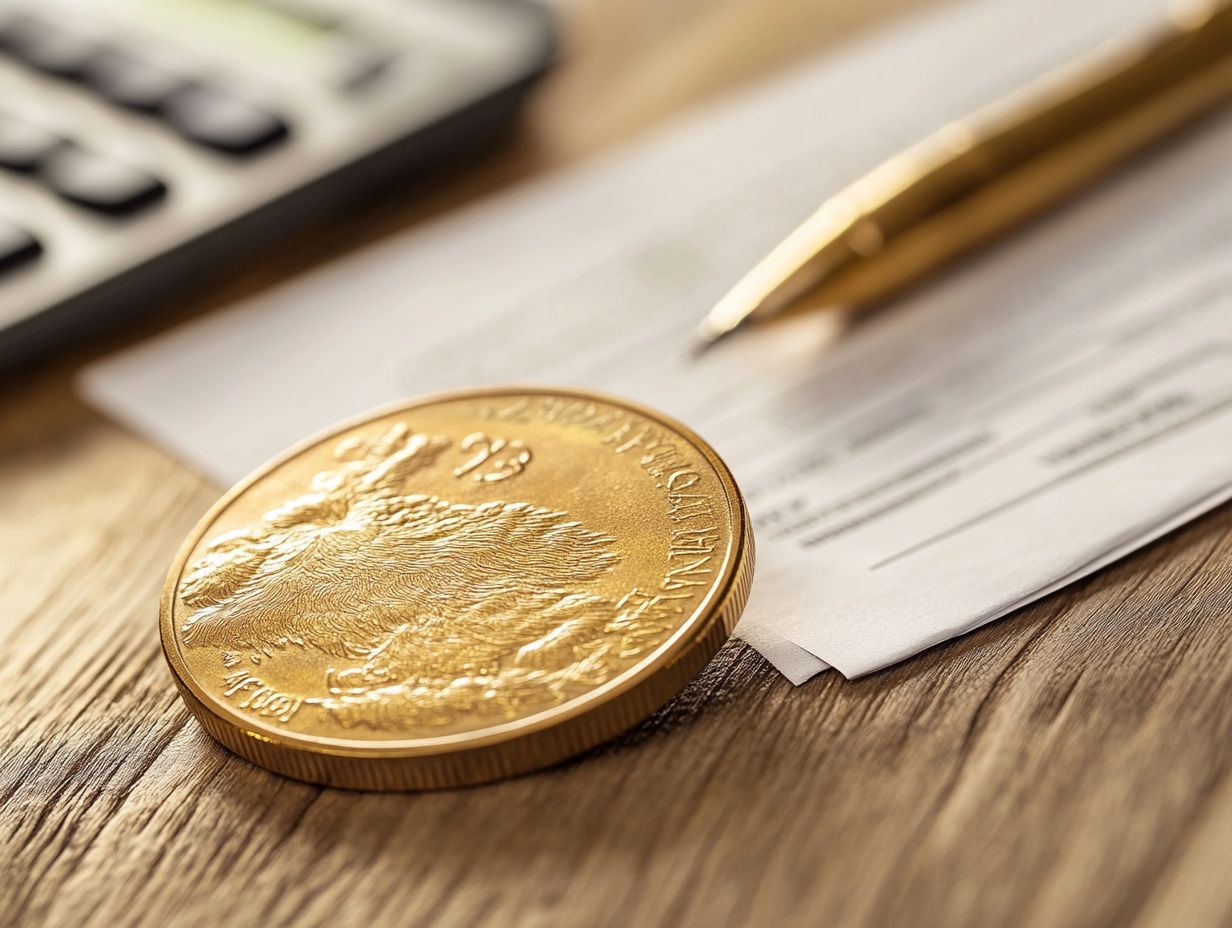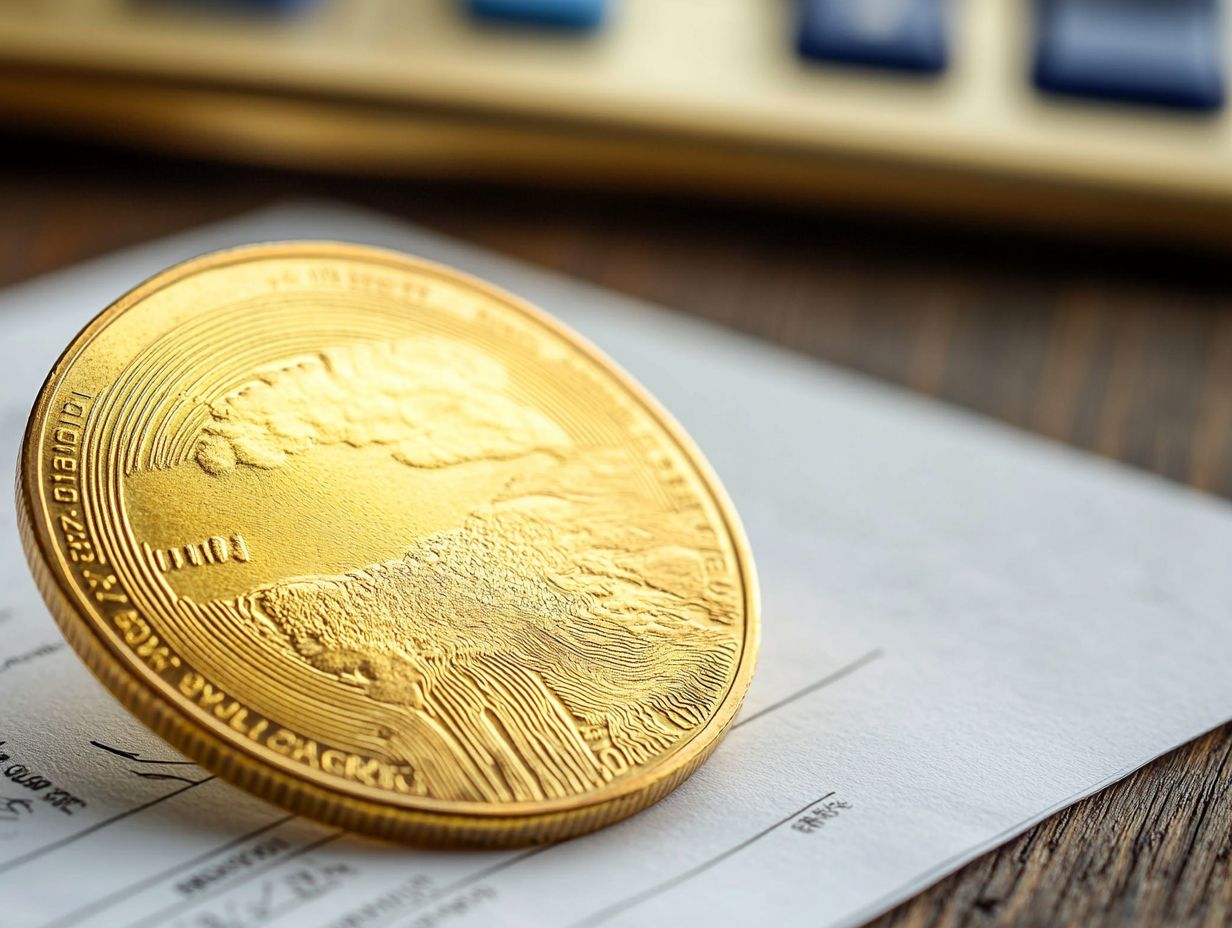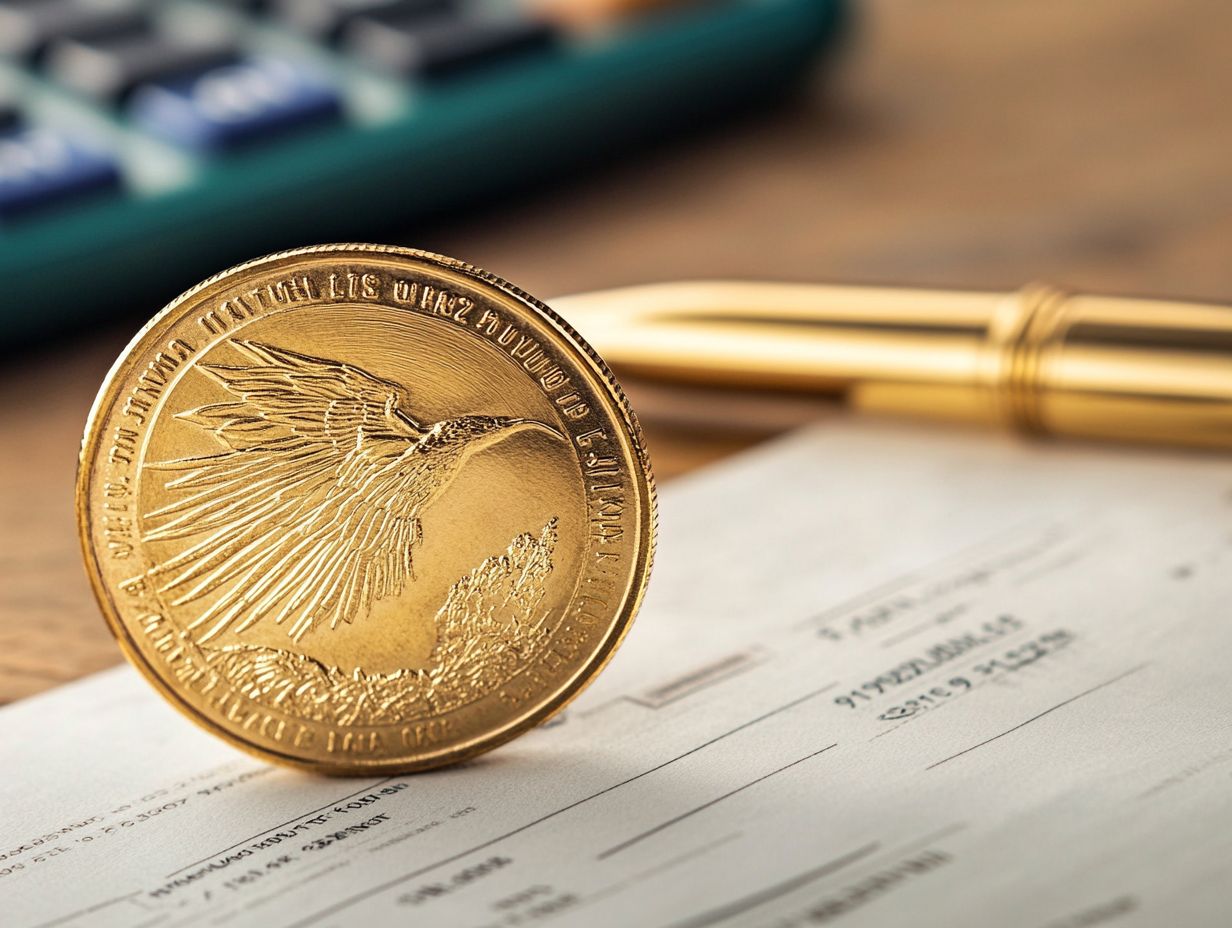What is a Gold IRA?
If you re contemplating diversifying your retirement portfolio, a Gold IRA could be a compelling choice. This specialized retirement account enables you to invest in physical gold and other precious metals, acting as a safeguard against inflation and economic uncertainty.
In this article, you ll delve into the benefits of a Gold IRA and explore the various types available. You’ll also follow a step-by-step guide for establishing your own account. It will assist you in selecting the right custodian while highlighting potential risks to keep in mind.
Continue reading to uncover how a Gold IRA can elevate your financial future.
Contents
- Key Takeaways:
- Benefits of Investing in a Gold IRA
- Types of Gold IRAs
- How to Open a Gold IRA
- Choosing the Right Gold IRA Custodian
- Potential Risks and Considerations
- Frequently Asked Questions
- How does a Gold IRA differ from a traditional IRA?
- Is it possible to transfer funds from a traditional IRA to a Gold IRA?
- What are the benefits of investing in a Gold IRA?
- Are there any restrictions on the type of gold that can be held in a Gold IRA?
- When can I start taking distributions from a Gold IRA?
Key Takeaways:

- A Gold IRA is a retirement account that allows individuals to invest in physical gold to protect against inflation and diversify their portfolio.
- There are two types of Gold IRAs: physical gold IRAs, which involve buying and storing actual gold, and paper gold IRAs, which use gold-based financial instruments.
- Opening a Gold IRA involves setting up an account and choosing a custodian, the company that manages your Gold IRA, who will hold and safeguard the gold on your behalf. It is important to carefully consider fees, taxes, and the custodian’s reputation before making a decision.
What is a Gold IRA?
A Gold IRA, or Individual Retirement Account, is a unique retirement account that enables you to invest in physical gold and other precious metals. This offers an alternative to traditional stock and bond investments.
This financial strategy has become increasingly popular among investors who are looking to protect their retirement funds from changes in the market and inflation, especially during uncertain economic times.
These accounts are governed by IRS regulations, which lay down specific rules regarding contributions, custodians, and the types of precious metals you can include. Understanding the nuances of these regulations is essential.
These guidelines determine not only the metals permissible such as gold, silver, and palladium but also the contribution limits, which generally align with those of traditional IRAs. You can contribute up to $6,000 annually, or $7,000 if you re 50 or older, all while enjoying tax advantages that can significantly enhance your long-term investment strategy.
When stock markets falter, incorporating precious metals into your retirement portfolio can serve as a valuable hedge against currency devaluation and global economic instability. This ultimately bolsters your financial security as you near retirement.
Benefits of Investing in a Gold IRA
Investing in a Gold IRA opens up exciting advantages for your financial future! It helps diversify your retirement portfolio, safeguard against inflation, and provides a secure refuge during economic uncertainty.
By dedicating a segment of your investments to precious metals, you fortify the stability of your retirement savings. This approach not only helps you navigate market fluctuations but also ensures the security of your financial assets for the long term.
Diversification and Protection Against Inflation
Diversification is essential when managing your retirement assets, and a Gold IRA offers an excellent way to incorporate precious metals into your investment portfolio. Gold, along with its shiny companions like silver and palladium, serves as a reliable hedge against inflation, safeguarding your wealth during times of economic uncertainty.
This strategy helps you navigate the risks associated with market changes while opening up potential growth avenues as you look to secure your retirement funds in the long run.
Historically, gold has outshone traditional equities during economic downturns. For instance, during the 2008 financial crisis, while the S&P 500 took a nosedive of nearly 38%, gold soared by around 25%, proving its prowess as a safe haven asset.
Tangible assets like gold provide psychological security. There s something reassuring about holding an asset you can physically touch, as opposed to intangible ones that can be swayed by market whims. This intrinsic value nurtures a sense of stability and confidence in your investment strategy, especially when financial markets seem as unpredictable as the weather.
Don t wait secure your retirement now! Take control of your financial future today!
Types of Gold IRAs
You have a variety of Gold IRAs at your disposal, each offering unique features and benefits tailored to different investment strategies while ensuring compliance with IRS regulations.
The most prevalent options include Physical Gold IRAs, which involve direct investments in tangible assets like gold bullion and coins. In contrast, Paper Gold IRAs grant you exposure to gold through financial instruments such as gold stocks or ETFs (exchange-traded funds).
Self-directed IRAs offer greater flexibility, allowing you to take a more hands-on approach in managing your retirement funds.
Physical Gold IRAs vs. Paper Gold IRAs

When deciding between Physical Gold IRAs and Paper Gold IRAs, weigh your investment options carefully. Consider whether you prefer the tangible allure of gold or the convenience of securities.
With Physical Gold IRAs, you re looking at direct ownership of gold bullion or coins, which require secure storage and come with custodian fees the costs for safely managing your gold investments. On the other hand, Paper Gold IRAs allow you to gain exposure to gold through ETFs or stocks, eliminating the hassle of physical possession.
You might find the intrinsic value and historical safety of physical gold particularly appealing, especially during economic downturns. However, be aware of the challenges that come with safe storage and insurance costs.
The liquidity of Paper Gold IRAs may also catch your eye, making it easier to buy and sell through brokerage accounts, though these could expose you to market volatility and potential management fees.
For instance, a Gold Eagle Coin exemplifies Physical Gold, while shares in a well-known gold ETF like SPDR Gold Shares represent Paper Gold. These options illustrate the diverse strategies available for securing wealth through precious metals.
How to Open a Gold IRA
Opening a Gold IRA requires a careful approach that demands planning and adherence to IRS regulations for a seamless experience. Start by selecting a reputable custodian, as this choice is pivotal.
Next, fund your account and choose the appropriate precious metals to establish a retirement account that aligns with your financial aspirations.
Understanding custody and storage fees, contribution limits, and the necessary documentation for an effective rollover or transfer can significantly streamline the entire process, making it less daunting.
Step-by-Step Guide to Setting Up an Account
Setting up a Gold IRA requires a thoughtful strategy, starting with the choice of a qualified custodian who specializes in precious metals and understands IRS regulations. After that, you ll need to fund your account through a transfer or rollover of your existing retirement funds.
Consider the specific types of gold investments you wish to feature in your portfolio, like gold bullion or American Eagle coins.
This process goes beyond merely evaluating custodians based on fees, reputation, and experience; it necessitates an understanding of the critical role they play in safeguarding your assets. Secure storage is essential, and a reputable custodian will offer vaulting services to protect your investments from theft or damage.
Moreover, adhering to IRS compliance is crucial to ensure your Gold IRA retains its eligibility for tax advantages. Common pitfalls include a lack of familiarity with IRS guidelines or failing to document transactions, which can lead to expensive penalties.
To reduce these risks, consult financial advisors and carefully review all terms and conditions associated with your investment selections.
Choosing the Right Gold IRA Custodian
Choosing the right Gold IRA custodian is a pivotal decision that directly influences the security and performance of your retirement funds.
Consider key factors such as the custodian’s experience, reputation, fees, and adherence to IRS regulations. A proficient custodian not only guides you through the intricacies of your Gold IRA but also offers valuable insights into investment options.
Act quickly to secure your retirement funds! A strong custodian will provide secure storage solutions tailored to your financial aspirations.
Factors to Consider When Selecting a Custodian
When selecting a custodian for your Gold IRA, consider several important factors. These include custodian fees, following IRS rules, and the storage solutions they offer for your precious metals.
Transparency regarding fees, such as maintenance and transaction costs, is essential to ensure your investment remains profitable over time.
The custodian’s reputation in the industry will significantly influence your overall experience. A reputable firm is more likely to provide superior customer service, which is invaluable when you have questions or encounter issues.
Seek custodians with a strong track record of compliance with regulatory standards, as this shows their dedication to protecting your assets. It s vital to closely examine all contractual agreements. By understanding hidden costs or potential penalties, you can avoid unexpected surprises later on, enabling you to make informed decisions that align with your financial goals.
Potential Risks and Considerations

Investing in a Gold IRA can enhance your retirement funds. However, recognize the potential risks that come with this choice.
Factors like custodian fees, market volatility, and the possibility of lower liquidity can significantly influence the overall performance of your investment portfolio. By understanding these risks, you can make informed decisions about your Gold IRA and how it integrates into your broader retirement strategy.
Understanding Fees and Taxes
Understanding the fees and taxes linked to a Gold IRA is essential for crafting a profitable investment strategy. Custodian fees can vary significantly and may include setup charges, annual maintenance fees, and transaction costs all of which can impact your overall returns.
Familiarize yourself with IRS regulations regarding taxes on transfers of assets and capital gains for effective financial planning. These costs can accumulate over time, potentially eroding your investment growth.
Compare various custodians and their fee structures before making a commitment. As a potential investor, consider tax strategies that can alleviate financial burdens. For instance, leveraging tax-deferred growth can enhance your returns, while understanding the timing of distributions can help preserve your wealth.
Smart financial planning can help you get the most out of your Gold IRA, paving the way for greater long-term benefits and stability in your retirement portfolio.
Market Volatility and Liquidity
Market volatility is crucial to weigh when investing in a Gold IRA. Changes in gold prices can greatly affect the value of your investment portfolio. While gold is often seen as a safe haven during economic uncertainty, liquidity can pose challenges; selling physical gold isn t always straightforward.
The interplay between market dynamics and the liquidity of Gold IRAs can deeply influence your investment strategy. As economic indicators like inflation rates, geopolitical tensions, or shifts in consumer behavior change, the demand for precious metals can also vary, affecting their market prices.
This inherent variability calls for a proactive strategy. Consider diversifying your portfolio by incorporating other liquid assets alongside gold, creating a balanced approach that helps mitigate risks. Stay informed about market trends and work with reputable dealers when trading physical gold to enhance liquidity and optimize your investment strategy.
Frequently Asked Questions
What is a Gold IRA?
A Gold IRA, or Individual Retirement Account, is a retirement investment option that allows individuals to hold physical gold as part of their IRA portfolio.
In conclusion, understanding the intricacies of Gold IRAs is vital for making informed investment decisions. By considering custodian fees, market volatility, and strategic planning, you can navigate this investment avenue successfully.
How does a Gold IRA differ from a traditional IRA?

A traditional IRA typically contains stocks, bonds, and mutual funds.
A Gold IRA includes physical gold assets such as coins, bars, and bullion. This diversification can provide a hedge against market volatility and inflation.
Is it possible to transfer funds from a traditional IRA to a Gold IRA?
Yes, you can move funds from a traditional IRA to a Gold IRA using a straightforward process. This lets you transfer money without any tax penalties.
What are the benefits of investing in a Gold IRA?
A Gold IRA offers benefits such as potential protection against economic downturns, inflation, and currency devaluation.
Plus, you get to own a real, tangible asset that you can see and touch, unlike traditional paper assets.
Are there any restrictions on the type of gold that can be held in a Gold IRA?
Yes, the IRS has strict guidelines on the types of gold that can be held in a Gold IRA.
The gold must meet certain purity standards and be in the form of coins or bars produced by a recognized mint. Collectible coins, such as rare or celebrity coins, are not eligible for a Gold IRA.
When can I start taking distributions from a Gold IRA?
Like traditional IRAs, distributions from a Gold IRA can be taken penalty-free after the age of 59 .
However, it is important to consult a financial advisor for guidance on the best time to start taking distributions based on your individual retirement goals.
Don’t miss out on the opportunity to secure your financial future with a Gold IRA!















